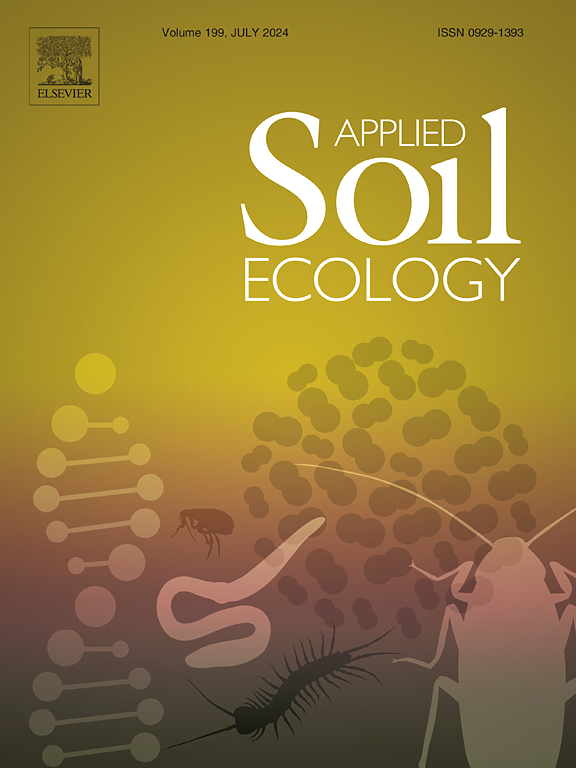Soil bacterial community composition rather than diversity exhibits edge effects in a farming-pastoral ecotone
IF 4.8
2区 农林科学
Q1 SOIL SCIENCE
引用次数: 0
Abstract
Edge effects have significant implications for ecological conservation and biodiversity maintenance. However, whether soil bacteria exhibit edge effects in large-scale ecotones remains unclear. In this study, we investigated soil bacterial communities in the farming-pastoral ecotone of northern China (FPEN), one of the world's largest ecotones, and compared them with those in adjacent grassland and cropland areas. Paired samples from both land types within the mosaic distribution of the ecotone revealed that land uses exerted relatively minor effects on soil bacterial communities in the FPEN. Across all samples, soil bacterial diversity, including Shannon and Faith's PD, followed a trend of grassland < ecotone < cropland. Interestingly, the entire ecotone acted as a semipermeable barrier, blocking 10.1 % of OTUs from moving from grassland to cropland and 9.3 % from cropland to grassland, while 3.6 % of OTUs were confined to the ecotone as endemic taxa. This led to the highest OTU richness in the FPEN. Compared to the adjacent ecosystems, the soil bacterial community composition in the ecotone showed significant differences and the lowest similarity. These results underscore the importance of identifying and preserving the intact FPEN to maintain soil bacterial diversity. Furthermore, the genera Ferruginibacter and Opitutus and the families Sporichthyaceae and P3OB-42 were identified as biomarkers of the ecotone, providing essential references for its accurate localization. In addition, the community similarity decreased with increasing environmental distance across all three ecosystems but was consistently lowest within the ecotone, indicating its susceptibility to environmental changes. Climate and vegetation conditions, particularly the normalized difference vegetation index (NDVI) and mean annual wind speed (MAWS), were the primary drivers of changes in soil bacterial diversity and community composition. In summary, soil bacterial community composition rather than diversity exhibited edge effects in the FPEN.
农牧生态区的土壤细菌群落组成而非多样性显示了边缘效应
边缘效应对生态保护和生物多样性维护具有重要意义。然而,土壤细菌在大尺度生态区是否表现出边缘效应仍不清楚。本研究调查了世界上最大的生态区之一--中国北方农牧生态区(FPEN)的土壤细菌群落,并将其与邻近草地和耕地的细菌群落进行了比较。从生态带镶嵌分布的两种土地类型中提取的配对样本显示,土地利用对FPEN土壤细菌群落的影响相对较小。在所有样本中,土壤细菌多样性,包括香农和费斯PD,都遵循草地< 生态带< 耕地的趋势。有趣的是,整个生态带就像一个半渗透的屏障,阻止了 10.1% 的 OTU 从草地转移到耕地,9.3% 的 OTU 从耕地转移到草地,而 3.6% 的 OTU 作为特有类群被限制在生态带中。这导致 FPEN 的 OTU 丰富度最高。与邻近生态系统相比,生态区土壤细菌群落组成差异显著,相似性最低。这些结果强调了识别和保护完整的 FPEN 以保持土壤细菌多样性的重要性。此外,Ferruginibacter 和 Opitutus 属以及 Sporichthyaceae 和 P3OB-42 科被确定为生态区的生物标志物,为其准确定位提供了重要参考。此外,在所有三个生态系统中,群落相似性随着环境距离的增加而降低,但在生态带内始终最低,这表明生态带易受环境变化的影响。气候和植被条件,尤其是归一化差异植被指数(NDVI)和年平均风速(MAWS),是土壤细菌多样性和群落组成变化的主要驱动因素。总之,在 FPEN 中,土壤细菌群落组成而非多样性表现出边缘效应。
本文章由计算机程序翻译,如有差异,请以英文原文为准。
求助全文
约1分钟内获得全文
求助全文
来源期刊

Applied Soil Ecology
农林科学-土壤科学
CiteScore
9.70
自引率
4.20%
发文量
363
审稿时长
5.3 months
期刊介绍:
Applied Soil Ecology addresses the role of soil organisms and their interactions in relation to: sustainability and productivity, nutrient cycling and other soil processes, the maintenance of soil functions, the impact of human activities on soil ecosystems and bio(techno)logical control of soil-inhabiting pests, diseases and weeds.
 求助内容:
求助内容: 应助结果提醒方式:
应助结果提醒方式:


